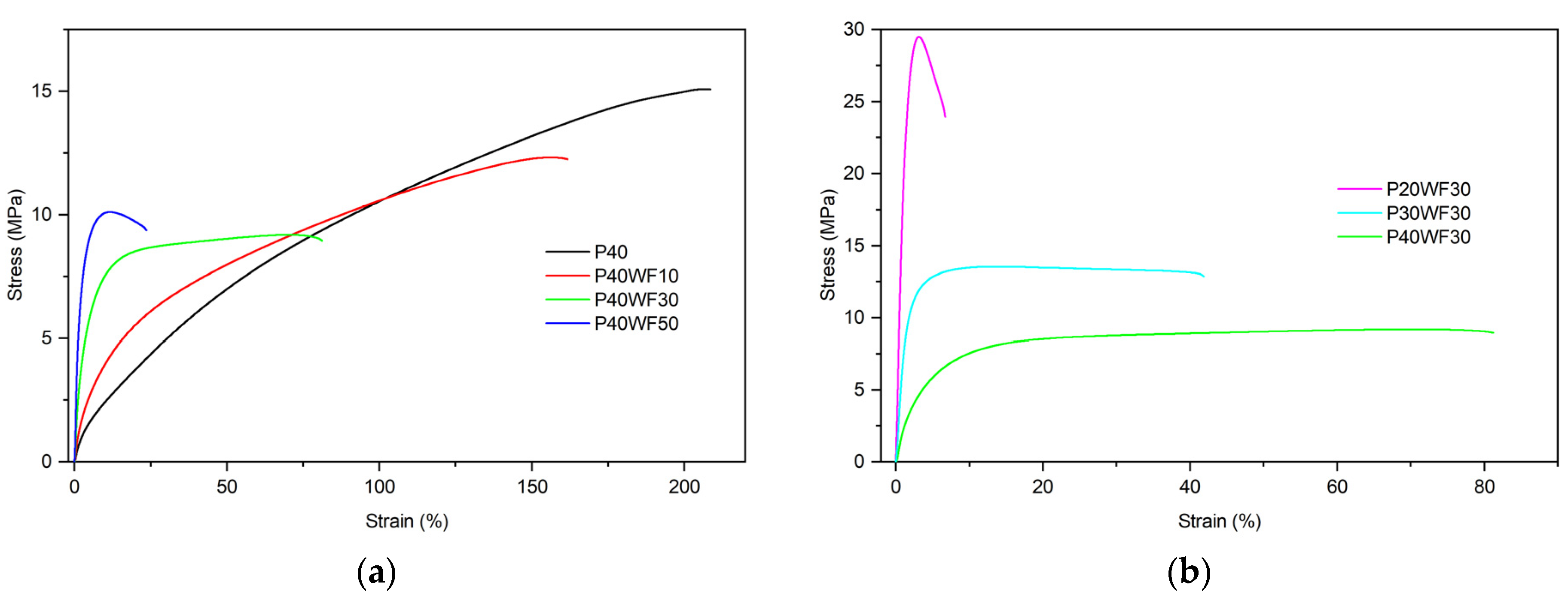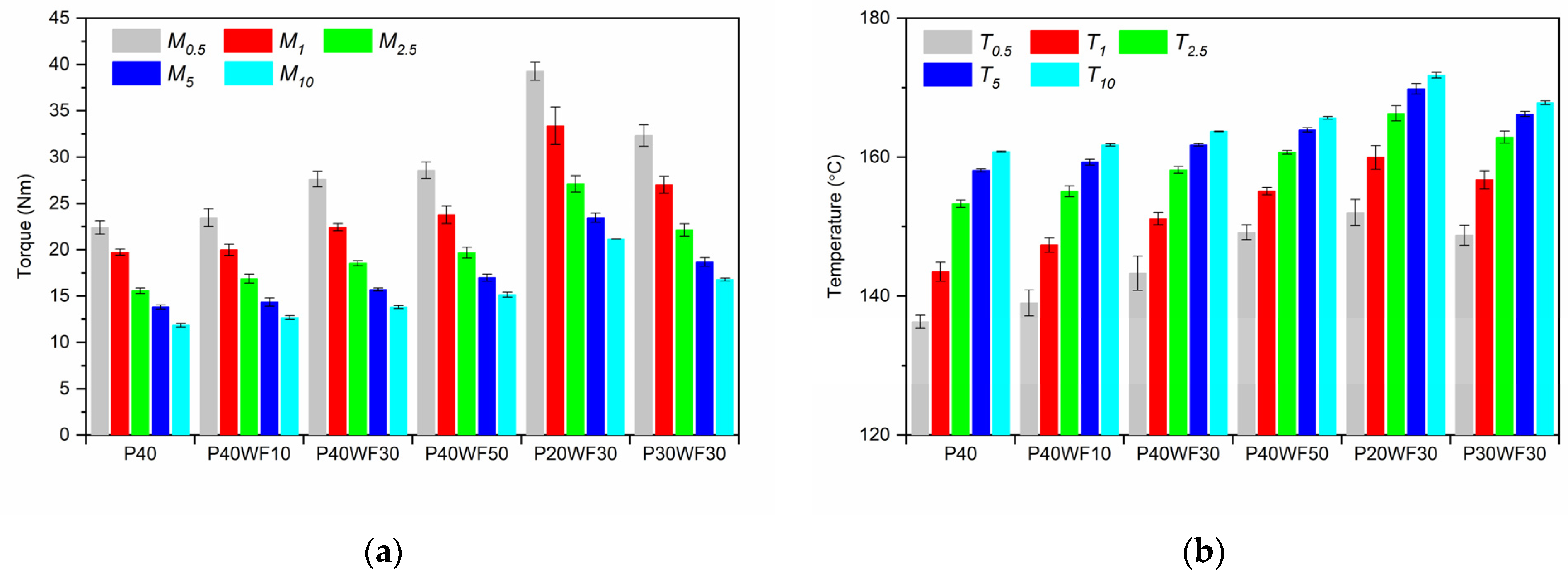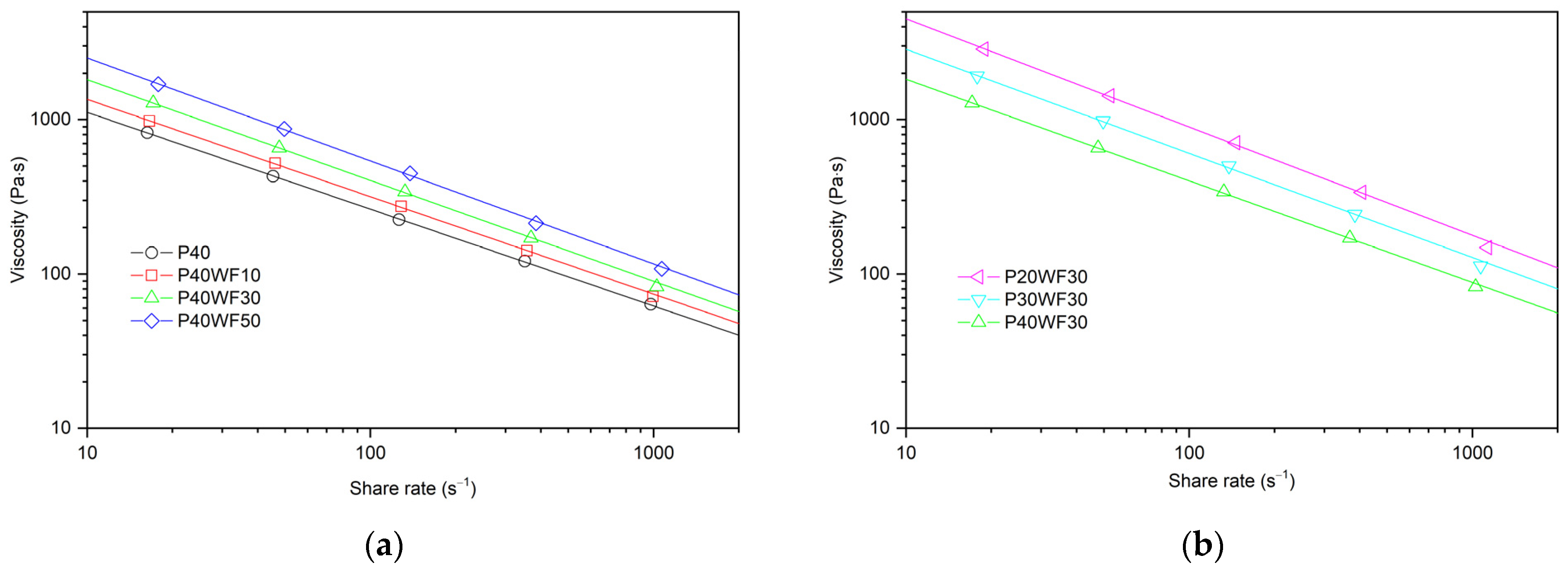Mechanical and Processing Properties of Plasticised PVC/Wood Composites
Abstract
1. Introduction
2. Materials and Methods
2.1. Materials
2.2. Materials Processing and Preparation of Sample for Testing
2.3. Testing Methods
2.3.1. Determination of Tensile Properties
2.3.2. Determination of the Glass Transition Temperature by DMTA
2.3.3. Determination of Water Absorption
2.3.4. Determination of Rheological Properties
2.3.5. Plastographometric Analysis
3. Results
3.1. Tensile Properties
3.2. DMTA
3.3. Water Absorption
3.4. Plastographometric Analysis
3.5. Rheological Properties
4. Conclusions
Author Contributions
Funding
Institutional Review Board Statement
Data Availability Statement
Conflicts of Interest
References
- Gupta, M.C.; Gupta, A.P. Polymer Composite; New Age International Limited: New Delhi, India, 2015. [Google Scholar]
- Askadskii, A.; Matseevich, T.; Askadskii, A.; Moroz, P.; Romanova, E. Structure and Properties of Wood-Polymer Composites (WPC); Cambridge Scholars Publishing: Newcastle, UK, 2019; ISBN 1527527964. [Google Scholar]
- Klyosov, A.A. Wood-Plastic Composites; John Wiley & Sons Inc.: Hoboken, NJ, USA, 2007. [Google Scholar]
- Wood-Plastic Composites Market. Available online: https://www.marketsandmarkets.com/Market-Reports/wood-plastic-composite-market-170450806.html?gad_source=1&gclid=CjwKCAjw4_K0BhBsEiwAfVVZ_26Or61RVPpEz3yY4fWNnH40-C1wKry92L_NfsZwo1Dm5b4BPQK5yBoCZpQQAvD_BwE (accessed on 21 July 2024).
- Chaudemanche, S.; Perrot, A.; Pimbert, S.; Lecompte, T.; Faure, F. Properties of an Industrial Extruded HDPE-WPC: The Effect of the Size Distribution of Wood Flour Particles. Constr. Build. Mater. 2018, 162, 543–552. [Google Scholar] [CrossRef]
- Marathe, D.S.; Joshi, P.S. Characterization of Highly Filled Wood Flour-PVC Composites: Morphological and Thermal Studies. J. Appl. Polym. Sci. 2009, 114, 90–96. [Google Scholar] [CrossRef]
- Mazzanti, V.; Mollica, F. A Review of Wood Polymer Composites Rheology and Its Implications for Processing. Polymers 2020, 12, 2304. [Google Scholar] [CrossRef] [PubMed]
- Andrzejewski, J.; Barczewski, M.; Szostak, M. Injection Molding of Highly Filled Polypropylene-Based Biocomposites. Buckwheat Husk and Wood Flour Filler: A Comparison of Agricultural and Wood Industry Waste Utilization. Polymers 2019, 11, 1881. [Google Scholar] [CrossRef] [PubMed]
- Andrzejewski, J.; Barczewski, M.; Czarnecka-Komorowska, D.; Rydzkowski, T.; Gawdzińska, K.; Thakur, V.K. Manufacturing and Characterization of Sustainable and Recyclable Wood-Polypropylene Biocomposites: Multiprocessing-Properties-Structure Relationships. Ind. Crops Prod. 2024, 207, 117710. [Google Scholar] [CrossRef]
- Jiang, H.; Kamdem, D.P. Development of Poly(Vinyl Chloride)/Wood Composites. A Literature Review. J. Vinyl Addit. Technol. 2004, 10, 59–69. [Google Scholar] [CrossRef]
- Lewandowski, K.; Zajchowski, S.; Tomaszewska, J. Wpływ Temperatury Wytłaczania Na Właściwości Kompozytów PVC/Drewno. Inżynieria Apar. Chem. 2010, 49, 71–72. [Google Scholar]
- Saeed, U.; Nawaz, M.A.; Al-Turaif, H.A. Wood Flour Reinforced Biodegradable PBS/PLA Composites. J. Compos. Mater. 2018, 52, 2641–2650. [Google Scholar] [CrossRef]
- Csikós, Á.; Faludi, G.; Domján, A.; Renner, K.; Móczó, J.; Pukánszky, B. Modification of Interfacial Adhesion with a Functionalized Polymer in PLA/Wood Composites. Eur. Polym. J. 2015, 68, 592–600. [Google Scholar] [CrossRef]
- Yu, S.; Wang, H.-M.; Xiong, S.-J.; Zhou, S.-J.; Wang, H.-H.; Yuan, T.-Q. Sustainable Wood-Based Poly(Butylene Adipate- Co -Terephthalate) Biodegradable Composite Films Reinforced by a Rapid Homogeneous Esterification Strategy. ACS Sustain. Chem. Eng. 2022, 10, 14568–14578. [Google Scholar] [CrossRef]
- Barczewski, M.; Andrzejewski, J.; Matykiewicz, D.; Krygier, A.; Kloziński, A. Influence of Accelerated Weathering on Mechanical and Thermomechanical Properties of Poly(Lactic Acid) Composites with Natural Waste Filler. Polimery/Polymers 2019, 64, 119–126. [Google Scholar] [CrossRef]
- Gozdecki, C.; Wilczyński, A.; Kociszewski, M.; Zajchowski, S. Properties of Wood–Plastic Composites Made of Milled Particleboard and Polypropylene. Eur. J. Wood Wood Prod. 2015, 73, 87–95. [Google Scholar] [CrossRef]
- Kociszewski, M.; Gozdecki, C.; Wilczyński, A.; Zajchowski, S.; Mirowski, J. Effect of Industrial Wood Particle Size on Mechanical Properties of Wood-Polyvinyl Chloride Composites. Eur. J. Wood Wood Prod. 2012, 70, 113–118. [Google Scholar] [CrossRef]
- Zajchowski, S.; Ryszkowska, J. Kompozyty Polimerowo-Drzewne—Charakterystyka Ogólna Oraz Ich Otrzymywanie z Materiałów Odpadowych. Polimery 2009, 54, 754–762. [Google Scholar]
- Mitaľová, Z.; Mitaľ, D.; Berladir, K. A Concise Review of the Components and Properties of Wood–Plastic Composites. Polymers 2024, 16, 1556. [Google Scholar] [CrossRef]
- Lewandowski, K.; Piszczek, K.; Zajchowski, S.; Mirowski, J. Rheological Properties of Wood Polymer Composites at High Shear Rates. Polym. Test. 2016, 51, 58–62. [Google Scholar] [CrossRef]
- Wilczynski, K.; Buziak, K.; Lewandowski, A.; Nastaj, A.; Wilczynski, K.J. Rheological Basics for Modeling of Extrusion Process of Wood Polymer Composites. Polymers 2021, 13, 622. [Google Scholar] [CrossRef]
- Lewandowski, K.; Piszczek, K.; Skórczewska, K.; Mirowski, J.; Zajchowski, S.; Wilczewski, S. Rheological Properties of Wood Polymer Composites at High Shear Rates—Evaluation of Additional Pressure Losses as a Result of Inlet Effects. Compos. Part A Appl. Sci. Manuf. 2022, 154, 106804. [Google Scholar] [CrossRef]
- Lewandowski, K.; Skórczewska, K. A Brief Review of Poly(Vinyl Chloride) (PVC) Recycling. Polymers 2022, 14, 3035. [Google Scholar] [CrossRef]
- Wilkes, C.E.; Summers, J.W.; Daniels, C.A.; Mark, T.B. PVC Handbook; Hanser: Munich, Germany, 2005. [Google Scholar]
- Wypych, G. PVC Formulary; ChemTec Publishing: Toronto, ON, Canada, 2020. [Google Scholar]
- Wypych, G. Handbook of Plasticizers; Elsevier: Toronto, ON, Canada, 2017. [Google Scholar]
- Daniels, P. How to Select Plasticizers for Plastics? Available online: https://polymer-additives.specialchem.com/selection-guide/plasticizers (accessed on 21 July 2024).
- Boukerrou, A.; Beztout, M.; Djidjelli, H.; Krim, S.; Hammiche, D. The Effect of Chemical Treatment of Cellulose with Epoxidized Soybean Oil (ESO) on the Properties PVC/Cellulose Composites. Mol. Cryst. Liq. Cryst. 2012, 556, 223–232. [Google Scholar] [CrossRef]
- Xu, K.; Kang, K.; Liu, C.; Huang, Y.; Zhu, G.; Zheng, Z.; Li, W. The effects of expoxidized soybean oil on the mechanical, water absorption thermal stability and melting processing properties of wood plastic composites. Wood Res. 2017, 62, 795–806. [Google Scholar]
- Hosseini, S.B. Effects of Dioctyl Phthalate and Density Changes on the Physical and Mechanical Properties of Woodflour/PVC Composites. J. Indian Acad. Wood Sci. 2013, 10, 22–25. [Google Scholar] [CrossRef]
- Siekierka, P.; Makarewicz, E.; Wilczewski, S.; Lewandowski, K.; Skórczewska, K.; Mirowski, J.; Osial, M. Composite of Poly(Vinyl Chloride) Plastisol and Wood Flour as a Potential Coating Material. Coatings 2023, 13, 1892. [Google Scholar] [CrossRef]
- Schiller, M. PVC Additives; Hanser Publishers: Munich, Germany, 2013. [Google Scholar]
- Grossman, R.F. Handbook of Vinyl Formulating; John Wiley & Sons, Inc.: Hoboken, NJ, USA, 2008. [Google Scholar]
- Gomez Ribelles, J.L.; Diaz-Calleja, R.; Ferguson, R.; Cowie, J.M.G. Glass Transition and Physical Ageing in Plasticized Poly(Vinyl Chloride). Polymer 1987, 28, 2262–2266. [Google Scholar] [CrossRef]
- ISO 527-1; Plastics—Determination of Tensile Properties—Part 1: General Principles. International Organization for Standardization: Geneva, Switzerland, 2012.
- Kloziński, A. Zastosowanie Techniki Pomiarowej Typu In-Line Do Oceny Właściwości Reologicznych Kompozytów Polietylenu z Węglanem Wapnia. Polimery 2016, 61, 788–798. [Google Scholar] [CrossRef]
- Kloziński, A.; Jakubowska, P. The Application of an Extrusion Slit Die in the Rheological Measurements of Polyethylene Composites with Calcium Carbonate Using an In-Line Rheometer. Polym. Eng. Sci. 2019, 59, E16–E24. [Google Scholar] [CrossRef]
- Kloziński, A.; Sterzyński, T. Ocena Poprawek w Pomiarach Reometrycznych Polietylenu, Cz. II. Wykładnik Płynięcia, Poprawka Rabinowitscha. Polimery 2007, 52, 855–862. [Google Scholar]
- Ward, J.M. Mechanical Properties of Solid Polymers; John Wiley & Sons Ltd.: New York, NY, USA, 1975. [Google Scholar]
- Lewandowski, M.; Piszczek, K.; Pieńkowska, M.; Lewandowski, K. Innovative Oligomeric Poly(Vinyl Chloride) Plasticizers for Specialized Applications. Polimery 2020, 65, 550–556. [Google Scholar] [CrossRef]
- Vigneshwaran, S.; Sundarakannan, R.; John, K.M.; Joel Johnson, R.D.; Prasath, K.A.; Ajith, S.; Arumugaprabu, V.; Uthayakumar, M. Recent Advancement in the Natural Fiber Polymer Composites: A Comprehensive Review. J. Clean. Prod. 2020, 277, 124109. [Google Scholar] [CrossRef]
- Maiti, S.N.; Singh, K. Influence of Wood Flour on the Mechanical Properties of Polyethylene. J. Appl. Polym. Sci. 1986, 32, 4285–4289. [Google Scholar] [CrossRef]
- George, W. PVC Degradation and Stabilization; ChemTec Publishing: Toronto, ON, Canada, 2015. [Google Scholar]
- Nor Arman, N.S.; Chen, R.S.; Ahmad, S. Review of State-of-the-Art Studies on the Water Absorption Capacity of Agricultural Fiber-Reinforced Polymer Composites for Sustainable Construction. Constr. Build. Mater. 2021, 302, 124174. [Google Scholar] [CrossRef]
- Sahu, P.; Gupta, M.K. Water Absorption Behavior of Cellulosic Fibres Polymer Composites: A Review on Its Effects and Remedies. J. Ind. Text. 2022, 51, 7480S–7512S. [Google Scholar] [CrossRef]
- Matykiewicz, D.; Dudziec, B.; Skórczewska, K.; Sałasińska, K. The Effect of Silanes Treatments on Thermal and Mechanical Properties of Nettle Fibre/Bio Epoxy Composites. J. Nat. Fibers 2024, 21, 2332913. [Google Scholar] [CrossRef]
- Mrad, H.; Alix, S.; Migneault, S.; Koubaa, A.; Perré, P. Numerical and Experimental Assessment of Water Absorption of Wood-Polymer Composites. Measurement 2018, 115, 197–203. [Google Scholar] [CrossRef]
- Lazrak, C.; Hammi, M. Experimental and Modeling Studies on Water Absorption Kinetics of Recycled Wood-Polymer Composites. J. Indian Acad. Wood Sci. 2022, 19, 52–60. [Google Scholar] [CrossRef]
- Yim, H.; Kim, D.S. Physical Properties of PVC/Aminosilane-Treated Wood Flour/Organoclay Composites. Polym. Adv. Technol. 2012, 23, 1441–1445. [Google Scholar] [CrossRef]
- Matuana, L.M.; Kim, J.W. Fusion Characteristics of Rigid PVC/Wood-Flour Composites by Torque Rheometry. J. Vinyl Addit. Technol. 2007, 13, 7–13. [Google Scholar] [CrossRef]
- Schramm, G. A Practical Approach to Rheology and Rheometry; Gebrueder HAAKE GmbH: Karlsruhe, German, 2007; ISBN 9780195187823. [Google Scholar]
- Piszczek, K.; Tomaszewska, J. Processing of Precipitated Nongranular PVC in the Brabender Measuring Mixer. J. Vinyl Addit. Technol. 2012, 18, 147–152. [Google Scholar] [CrossRef]
- Lewandowski, K.; Tomaszewska, J.; Mirowski, J. Ocena Zmian Stopnia Zżelowania PVC w Kompozytach Polimerowo-Drzewnych. Czas. Tech. 2009, 106, 409–413. [Google Scholar]
- Cogswell, F.N. Polymer Melt Rheology, A Guide for Industrial Practice; Woodhead Publishing Ltd.: Cambridge, UK, 2003. [Google Scholar]
- Kukla, C.; Duretek, I.; Gonzalez-Gutierrez, J.; Holzer, C. Rheology of Highly Filled Polymers. In Polymer Rheology; Rivera-Armenta, J.L., Salazar Cruz, B.A., Eds.; IntechOpen: London, UK, 2018. [Google Scholar]
- Shenoy, A.V. Rheology of Filled Polymer Systems; Kluwer Academic Publishers: Dordrecht, The Netherlands; Boston, MA, USA; London, UK, 1999; ISBN 0412831007. [Google Scholar]
- Gupta, R.K. Polymer and Composite Rheology; Marcel Dekker: New York, NY, USA, 2000. [Google Scholar]
- Stabik, J. Badania Ruchu Ziaren Napełniaczy Podczas Przepływu Polimerów. Polimery 2004, 49, 712–718. [Google Scholar] [CrossRef][Green Version]
- Stabik, J. Wpływ Cech Geometrycznych Ziaren Napełniaczy Na Lepkość Polietylenu i Polistyrenu w Stanie Uplastyczznionym. Polimery 2004, 48, 634–640. [Google Scholar] [CrossRef]






| Material | Contribution of Components to the Material, phr | ||||
|---|---|---|---|---|---|
| Dry Blend | Wood Flour | ||||
| PVC | DINP | Patstab 2301 | Naftolube FTP | ||
| P40 | 100 | 40 | 4 | 1 | 0 |
| P40WF10 | 100 | 40 | 4 | 1 | 10 |
| P40WF30 | 100 | 40 | 4 | 1 | 30 |
| P40WF50 | 100 | 40 | 4 | 1 | 50 |
| P20WF30 | 100 | 20 | 4 | 1 | 30 |
| P30WF30 | 100 | 30 | 4 | 1 | 30 |
| Process | Processing Temperature Setting, °C | ||||||||||
|---|---|---|---|---|---|---|---|---|---|---|---|
| Extrusion | z1 | z2 | z3 | z4 | z5 | z6 | z7 | z8 | z9 | Connector | Head |
| 90 | 100 | 120 | 130 | 140 | 145 | 155 | 170 | 170 | 165 | 155 | |
| Injection moulding | z1 | z2 | z3 | z4 | Injection mould | ||||||
| 90 | 120 | 170 | 170 | 18 | |||||||
| Material | Tensile Modulus, MPa | Tensile Strength, MPa | Strain at Strength, % |
|---|---|---|---|
| P40 | 18 (1) | 15.0 (0.2) | 205 (5) |
| P40WF10 | 34 (1) | 12.3 (0.2) | 153 (2) |
| P40WF30 | 112 (3) | 9.1 (0.1) | 71 (2) |
| P40WF50 | 274 (8) | 10.2 (0.1) | 12 (0) |
| P20WF30 | 1760 (40) | 29.5 (0.6) | 3 (0) |
| P30WF30 | 463 (9) | 13.5 (0.1) | 14 (1) |
| Material | Tg, E′, °C | E′, MPa | tanδmax, °C | ||||
|---|---|---|---|---|---|---|---|
| Onset | Inflection | Offset | −25 °C | 0 °C | 25 °C | ||
| P40 | −46.3 (0.3) | −14.9 (2.8) | 25.7 (0.4) | 2925 (25) | 1538 (21) | 487 (18) | 49 (2) |
| P40WF10 | −42.5 (0.4) | −4.2 (1.3) | 26.6 (1.9) | 3346 (84) | 1763 (46) | 643 (40) | 45.6 (3.0) |
| P40WF30 | −40.3 (0.2) | 0 (1.1) | 36.6 (0.4) | 3911 (319) | 2429 (209) | 1034 (109) | 53.1 (0.2) |
| P40WF50 | −36.6 (2.2) | 2.8 (3.7) | 42.5 (0.9) | 4335 (420) | 2909 (315) | 1418 (181) | 5.9 (0.6) |
| P20WF30 | 21.2 (0.9) | 59.8 (0.6) | 73.3 (1.1) | 4092 (121) | 3626 (87) | 2893 (72) | 74.7 (0.8) |
| P30WF30 | −20.5 (0.5) | 26.4 (0.9) | 57.2 (0.7) | 4242 (142) | 3334 (131) | 1994 (94) | 69.4 (0.8) |
| Material | n, | k, Pa·sn | R2 |
|---|---|---|---|
| P40 | 0.373 (0.004) | 4732 (64) | 1 |
| P40WF10 | 0.369 (0.006) | 5793 (127) | 0.9997 |
| P40WF30 | 0.341 (0.006) | 8337 (201) | 0.9997 |
| P40WF50 | 0.333 (0.008) | 11,688 (356) | 0.9996 |
| P20WF30 | 0.299 (0.011) | 22,652 (1043) | 0.9989 |
| P30WF30 | 0.347 (0.004) | 8189 (113) | 0.9999 |
Disclaimer/Publisher’s Note: The statements, opinions and data contained in all publications are solely those of the individual author(s) and contributor(s) and not of MDPI and/or the editor(s). MDPI and/or the editor(s) disclaim responsibility for any injury to people or property resulting from any ideas, methods, instructions or products referred to in the content. |
© 2024 by the authors. Licensee MDPI, Basel, Switzerland. This article is an open access article distributed under the terms and conditions of the Creative Commons Attribution (CC BY) license (https://creativecommons.org/licenses/by/4.0/).
Share and Cite
Lewandowski, K.; Altmajer, P.; Borkowska, Z.; Skórczewska, K. Mechanical and Processing Properties of Plasticised PVC/Wood Composites. Polymers 2024, 16, 2204. https://doi.org/10.3390/polym16152204
Lewandowski K, Altmajer P, Borkowska Z, Skórczewska K. Mechanical and Processing Properties of Plasticised PVC/Wood Composites. Polymers. 2024; 16(15):2204. https://doi.org/10.3390/polym16152204
Chicago/Turabian StyleLewandowski, Krzysztof, Piotr Altmajer, Zuzanna Borkowska, and Katarzyna Skórczewska. 2024. "Mechanical and Processing Properties of Plasticised PVC/Wood Composites" Polymers 16, no. 15: 2204. https://doi.org/10.3390/polym16152204
APA StyleLewandowski, K., Altmajer, P., Borkowska, Z., & Skórczewska, K. (2024). Mechanical and Processing Properties of Plasticised PVC/Wood Composites. Polymers, 16(15), 2204. https://doi.org/10.3390/polym16152204






